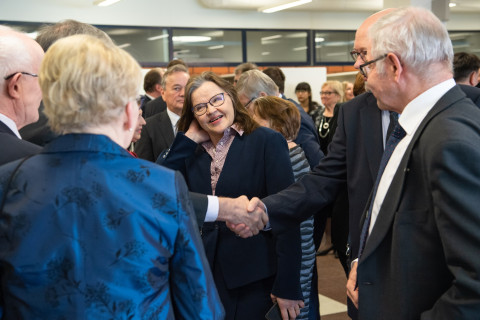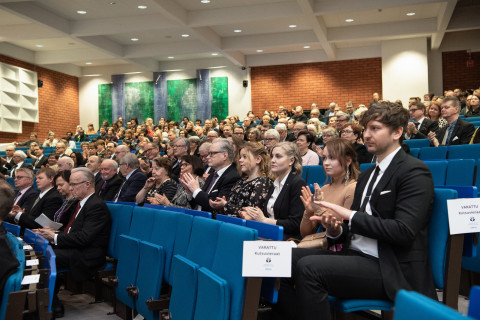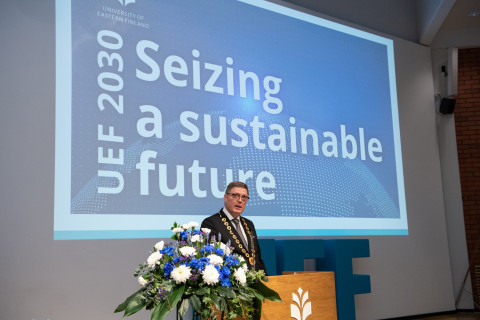What has made the University of Eastern Finland a success story, and how does that story continue? Rector Jukka Mönkkönen and WMO Secretary-General Petteri Taalas looked back on successful choices and envisioned the future in the university’s 10th anniversary celebration.
The Universities of Joensuu and Kuopio merged to constitute the University of Eastern Finland in the beginning of 2010, and this year marks the university’s 10th anniversary. The jubilee year’s main event, the 10th anniversary celebration, was open to everyone at the Kuopio Campus on 20 February 2020.
Pioneering choices stand the test of time
“In the light of its strategies, the university's journey so far can be described as one from multidisciplinarity to interdisciplinarity,” Rector Jukka Mönkkönen said in his opening speech.
Ever since its establishment, the University of Eastern Finland has been one of the largest universities in Finland, and the most multidisciplinary one in terms of its fields of study.
Mönkkönen pointed out that the strategic areas of expertise of the campuses supplemented one another at the time of the merger.
“The strategic areas of expertise of the University of Joensuu pertained to education, forests, certain fields of natural sciences, and strong research relating to Russia. At the University of Kuopio, the areas of expertise stemmed from medicine and health sciences, environmental sciences and research addressing well-being technologies and welfare services.”
These served as the foundation for the areas of expertise in the University of Eastern Finland's first strategy.
According to Mönkkönen, the synergies offered by multidisciplinarity were fully reaped in the university’s strategy for 2015–2020.
“We described our profile through global challenges that were built around our existing strengths. This time, however, we used larger themes that crossed the boundaries of disciplines, faculties and campuses. The strategy sought multidisciplinary solutions to complex global challenges that are also known as wicked problems. “
The strategy was praised for being pioneering, and other Finnish universities, too, started to formulate their strategies around the same idea.
“This strategy turned out to be so good that when we renewed our strategy for this decade, we didn’t have to make any major structural changes to it. Multidisciplinarity made possible by the presence of multiple disciplines in our university, as well as its next stage of evolution, interdisciplinarity, continue to be key goals in our research and education.”
According to international evaluators, the university is, already now, one of the most advanced universities in terms of the multidisciplinarity and interdisciplinarity of its research. Making extensive use of new and multidisciplinary teaching methods, the university’s education has also attracted attention.
“We will also pay more attention to the implementation of our strategy. The idea is that the university's structure and profile areas will stay relevant throughout the new decade, and that we’ll develop our activities through continuously evolving programmes that address our research, education, and staff and student well-being. This allows us to optimally combine our long-term commitments relating to research and education with the inevitable needs for development that arise from our rapidly changing operating environment.”

New strategy published – activities are developed through continuously evolving programmes
The new strategy of the University of Eastern Finland, UEF 2030 – Seizing a sustainable future, was published in connection with the 10th anniversary celebration. The profile areas defined in the strategy are Ageing, lifestyles and health, Cultural encounters, mobilities and borders, Diversifying learning and interaction, and Environmental change and sustainable use of natural resources.
The continuously evolving programmes promote world-class interdisciplinary research, open science, science communication and the impact of research. Student-centred and networked learning environments, continuous learning and internationality in education also stand at the core of the programmes. Measures drawing upon community spirit, competence renewal and open interaction are used to make investments in the well-being of the academic community, and in smooth services.
Get to know UEF's strategy: UEF 2030 – Seizing a sustainable future

Vitality from the merger
“In many ways, the University of Eastern Finland is a wonderful success story. First of all, it is an example of a successful university merger. Few other mergers have been as successful or painless as this one. For that, everyone involved in the merger, and the people behind the idea, deserve a thank you,” said Petteri Taalas, Secretary-General of the World Meteorological Organisation, WMO, in his speech.
Taalas served as the chair of the university’s board from the time the merger was planned in 2009 up until 2015.
“In my opinion, the merger of the universities went surprisingly well.”
“Everything was driven by the university’s vitality and competitiveness, which served as the foundation for our choices.”
According to Taalas, Rector Perttu Vartiainen and Rector Matti Uusitupa, who led the merger, understood how vulnerable small universities are and, on the other hand, how much potential a larger university could offer.
“Thanks to these visionary minds, we now have a highly dynamic university.”
Vartiainen was elected as the first Rector of the University of Eastern Finland and, according to Taalas, his successor, the university’s current Rector Jukka Mönkkönen, has continued his work in an outstanding manner.
Taalas has made a long career as Director General of the Finnish Meteorological Institute. There too, he has noticed the benefits of collaboration and joining forces both in international projects as well as locally, such as in Kuopio, where the Finnish Meteorological Institute decided to relocate its activities to the university campus.
“I wish to encourage you all to join forces, both within the university and across organisational boundaries, as well as internationally. Sometimes, that means getting out of one’s comfort zone and even taking some risks, but the outcome can be phenomenal.”
“Another opportunity and challenge is for business and industry to make better use of the university’s intellectual and innovation capacity.”
According to Taalas, increasingly active collaboration is also needed to safeguard the vitality of eastern Finland.
“The discussions I had with local entrepreneurs at one time revealed that there are prejudices on both sides. Offering entrepreneurship training to students would also be beneficial.”
Taalas highlighted international students studying in Finland as an important source of future potential and, according to him, facilitating their staying in Finland should be made easier.
An honorary doctorate will be conferred upon Taalas in the University of Eastern Finland's doctoral conferment ceremony in June 2020.

University's history book was launched, researchers and teachers presented with awards
The anniversary celebration witnessed the launch of a book about the history of the University of Eastern Finland. Authored by Senior Researcher Mikko Kohvakka and Senior University Lecturer Arto Nevala, the book is entitled Itä-Suomen yliopisto – Reformi ja sen tekijät (University of Eastern Finland - Reform and its makers). Kohvakka introduced the book together with Professor and Rector Emeritus Matti Uusitupa, chair of the history committee.

